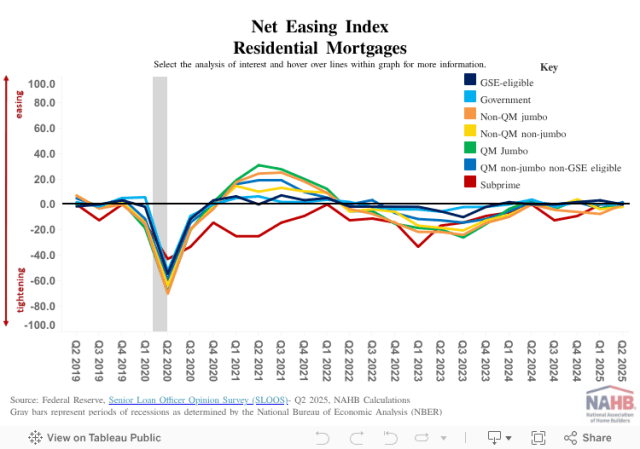Single-Family Construction Loan Volume Falls Back
Jesse Wade2025-09-24T08:17:10-05:00The NAHB Land Acquisition, Development and Construction (AD&C) loan survey in the second quarter reported tightening credit conditions for builders. Consequently, FDIC data reporting the outstanding volume of 1-4 family construction loans fell in the second quarter. The total volume of all AD&C loans fell for the sixth straight quarter, led by declines in other real estate development loans. In the second quarter of 2025, the total level of outstanding acquisition, development, and construction loans fell to $469.1 billion, down 5.3% from one year ago. This was again led by a drop in other real estate development loans, which fell to $379.3 billion, down 2.3% compared to the quarter prior. The volume of 1-4 family residential construction and land development loans totaled $89.8 billion in the second quarter, down 2.0% from one year ago. On a quarterly basis, this volume is down 0.3% from $90.0 billion in the first quarter. It is worth noting, the FDIC data represent only the stock of loans, not changes in the underlying flows, so it is an imperfect data source. Nonetheless, lending remains much reduced from years past. The current amount of existing 1-4 family residential AD&C loans now stands 56% lower than the peak level of residential construction lending of $204 billion reached during the first quarter of 2008. Alternative sources of financing, including equity partners, have supplemented this capital market in recent years. Quality Metrics of Construction Loans As the volume of outstanding 1-4 family residential construction loans fell, the volume of loans 30+ days past due or nonaccrual status also fell. The total level of past due and nonaccrual loans was $1.1 billion, down from $1.2 billion the quarter prior. As a share of the total 1-4 family residential construction loan volume, this accounts for 1.2%. The level of loans in nonaccrual status was $572.1 million while the level for 30-89 past due was $469.2 million. Loans are classified as nonaccrual when one or more of the following conditions apply: the loan is 90 days or more past due on principal or interest (unless it is well-secured and in the process of collection); the bank no longer expects full repayment of principal and interest; or the borrower’s financial condition has significantly deteriorated, warranting cash-basis accounting. Discover more from Eye On Housing Subscribe to get the latest posts sent to your email.


